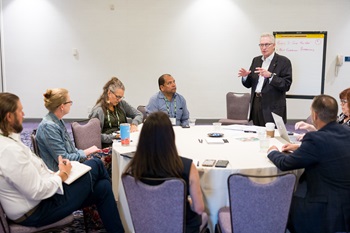<p style="text-align:center;"><em>FMI’s FreshForward conference gathered industry leaders to explore opportunities in fresh foods through highlighting research, strategies, and policy insights to help retailers and suppliers continue to elevate the fresh sector.</em></p><p>By: Rick Stein, Vice President, Fresh Foods, FMI</p><p><img src="https://www.fmi.org/images/default-source/blog-images/freshforward-focus-group-2025.tmb-large-350-.jpg?Culture=en&sfvrsn=20fa1568_1" style="float:right;margin:10px;" alt="FreshForward focus group 2025" class="-align-right" sf-size="3321453" />“Fresh is in a really good place, and we have an opportunity to bring it to a great place.”<br /></p><p>That’s how Leslie Sarasin, FMI’s president and CEO, characterized the fresh foods industry during her opening keynote presentation at the <a href="https://www.fmi.org/fresh-forward">FreshForward conference</a> this month in San Diego. <br /></p><p>She relayed fresh industry research showing positive trends and posed a challenge to overcome hurdles and further raise the game.<br /></p><p>“What would it take to elevate our game from good to great?” she asked, borrowing a phrase from the classic business book by management guru Jim Collins. “Because we play in a league where the field is already huge and new competitors are springing up every day.” <br /></p><p>Speakers at FreshForward took up Leslie’s challenge by relaying fresh opportunities tied to this year’s conference focus areas — labor, health and well-being and meals. <br /></p><h5>Sharing Fresh Stats</h5><p>Leslie shared research from FMI’s <a href="https://www.fmi.org/forms/store/ProductFormPublic/the-state-fresh-foods-2025">The State of Fresh Foods 2025</a> report that showed a progression of trends in this industry sector. </p><ul><li>87% of responding food retailers said they used fresh prepared/foodservice programs as a top differentiation strategy in 2024, and 63% reported it was a fruitful strategy. </li><li>84% reported local assortment through the produce department was their approach to setting themselves apart from the field, and 73% felt they succeeded at executing that strategy. </li><li>68% said they were increasing space (and none were decreasing space) dedicated to fresh grab-and-go selections.<em> </em><br /></li></ul><h5>Overcoming Labor Hurdles</h5><p>The conference’s panel on labor in fresh outlined opportunities to communicate robust career paths to attract and retain employees and offer innovative strategies to guide employees on interacting with new technologies. <br /></p><p>Panelist David Kopsch, senior principal, Mercer, said employees want to interact with technology and AI, and they also want to be able to help manage change. “At the end of the day, people buy from people. When something goes wrong, a shopper wants to talk to a manager.”<br /></p><h5>Capturing Meal Occasions</h5><p>Speakers on the Meals panel cited opportunities to raise the game with enhanced quality in foodservice and improved abilities for shoppers to identify convenient, time-saving options. <br /></p><p>Jeremy Gosch, chairman of the board and CEO, Hy-Vee, who introduced the panel, noted a shift toward more mindful and budget-conscious shopping. “About 86% of eating occasions in the U.S. are sourced from home due to ongoing economic pressures,” he said. “As grocers, we can inspire consumers and influence their next meal occasions or purchases.”<br /></p><h5>Pursuing Health and Well-being Strategies</h5><p>Speakers in the Health and Well-being panel said shoppers are paying more attention to health and fresh, and that the industry needs to provide solutions that are nutritious, affordable and personalized. <br /></p><p>Panelist Laura Brown, Kroger’s director of Nutrition, said GLP-1 usage has driven many shoppers to follow more nutrition-centered strategies. “People are talking about nutrition more,” she elaborated. “They are looking for nutrient-dense, high protein, hydration and high-fiber.” <br /></p><h5>Addressing Policy Issues</h5><p>Closing keynoter Hunt Shipman, principal and director, Cornerstone, underscored the importance of the current food policy landscape to food industry organizations. He cited a range of topical issues with policy tie-ins, including tariffs, the MAHA movement, ultra-processed foods and federal nutrition programs. “Nutrition policy is a highly dynamic area related to fresh foods and consumers’ access and attitudes,” he said. <br /></p><h5>Acting on the Insights</h5><p>FreshForward, developed in collaboration with Deloitte, is always full of insights to help guide retailers and suppliers in their fresh strategies. We’ll be publishing more takeaways from FreshForward soon — including key action steps identified by attendees during breakout groups. The fresh industry is stronger when its leaders gather for education, collaboration and addressing challenges. </p>
[#item_full_content]




